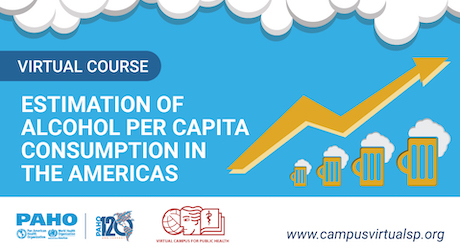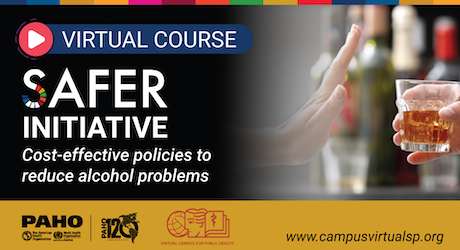Two new virtual courses on alcohol policy have been released on PAHO’s Virtual Campus for Public Health. These two innovative, new self-learning and free courses are for health professionals, advocates and policy makers.
Building capacity in the alcohol prevention field is essential to strengthen and develop the research, advocacy and public policies to better protect more people from alcohol harm. Based on this premise, the Pan American Health Organization (PAHO) has developed a series of online courses over the years. And it has released two new courses that complement the existing ones.
- Estimation of Alcohol Per Capita Consumption in the Americas, and
- SAFER initiative: cost-effective policies to reduce alcohol problems.
Both online courses are designed to provide knowledge on the tools used by the World Health Organization to support countries reporting data on alcohol use and advancing cost-effective strategies to prevent and reduce the harms caused by the products and practices of the alcohol industry.
The courses were released with the help of a virtual launch event, where also Movendi International President Kristina Sperkova participated.
Ms Sperkova and Movendi International were tasked with developing the course on cost-effective alcohol policies.
These two new capacity-building initiatives further add to PAHO’s self-learning virtual campus on alcohol issues. Currently, eight courses have been developed both in English and Spanish (three of them are also available in Portuguese) and over 59,000 people from nearly 60 countries have attended them. They are recognized as highly valuable and have been adapted by individual countries and promoted by other WHO regions.
Estimation of Alcohol Per Capita Consumption in the Americas
The annual per capita consumption of alcohol (APC) is the most accurate and reliable indicator used for monitoring trends in alcohol consumption, harms and policy implementation at national and subnational levels. It is one of the indicators of the SDG 2030 agenda (3.5.2). Despite the existence of data at country level to calculate this indicator, most countries do not know how to obtain the data and calculate the indicator so they can use for public health surveillance in the alcohol field.
Purpose
This course provides detailed information on the data sources needed to calculate this indicator annually, how to calculate it based on tool developed by the PAHO/WHO Collaborating Center in Toronto (Center for Addiction and Mental Health) and used by WHO for its global reports on alcohol and health.
Learning Outcomes
- Become familiar with the data sources required to calculate APC,
- Become familiar with the APC tool to calculate the indicator,
- Understand the need and value of the APC,
- Be able to collate national data and use the tool to report on SDG target indicator, and
3.5.2 and use the annual APC for alcohol policy monitoring.
Participants profile
Anyone interested in the subject. Public health professionals, researchers, students, statisticians, and epidemiologists working with alcohol related information.
Duration
10 hours
Methodology
This course has a self-management methodology, meaning participants can do it at their own pace. The exercises serve to self-regulate own learning and identify those elements or units for repeated or deeper review. The course consists of audio presentations, two examples based on national data and automated quizzes in order to apply the acquired learning.
Course Structure
| Module 1: Introduction | What is the APC Alcohol consumption and Sustainable Development Goals (SDG) WHO Global Alcohol Strategy PAHO alcohol action plan Basic indicators of alcohol consumption |
| Module 2: Adult percapita consumption | How is the APC calculated Data source What information is used by WHO to estimate the APC in a country |
| Which countries in the Americas estimate the APC | |
| Module 3: The APC tool | How and who needs to be involved at country level |
| Module 4: Using the APC tool | Process for estimating APC |
| Module 5: Examples from countries in the Americas | How APC is estimated in some countries of the Americas |
SAFER Initiative: cost-effective policies to reduce alcohol problems
This course is a 5-module interactive online self-study course.
Each module allows participants to develop knowledge about what safer is and how it is implemented.
Each module consists of a presentation, assessment quiz, and an expert video.
There are three ways to understand SAFER
- Firstly, SAFER can be understood as an acronym for the most cost-effective interventions to prevent and reduce alcohol harm.
- The SAFER technical package outlines ways how countries can implement the SAFER interventions.
- The second way to understand SAFER is as an initiative and a partnership between the World Health Organization, the United Nations Interagency Task Force on NCDs and the United Nations Development Program. These agencies, together with civil society organizations, advocate for and facilitate implementation of the SAFER alcohol policy blueprint.
- They also support the development of high impact alcohol policy solutions and build partnerships and initiatives around advocacy, facilitation, and support for alcohol policy.
- Thirdly, SAFER can be viewed as a compelling narrative about the great potential of alcohol policy through the SAFER technical package supported by the SAFER strategies.
Purpose
To provide a comprehensive toolbox and guide to understanding and implementing the SAFER blue print and strategies.
Learning Objectives
At the end of the course, the participant will be able to:
- Increase the familiarity with the SAFER interventions and strategies,
- Develop the theoretical foundation necessary in order to initiate the process of SAFER implementation on the country and even on the local level, and
- Build capacity to overcome barriers for implementation of the SAFER technical package.
Duration
10 hours
Methodology
This course has a self-management methodology, so that participants can take the course at their own pace.
Course Structure
| Module 1: Introduction | The first module introduces SAFER |
| Module 2: Safer interventions | The second module dives into all five of the SAFER interventions |
| Module 3: Implement | Module three is about the implementation of SAFER and all of the details that need to be considered for effective implementation |
| Module 4: Monitor and Evaluate | Module four is about monitoring, surveillance, and evaluation of SAFER implementation |
| Module 5: Protect | Finally, module five deals with issues around how to protect SAFER from alcohol industry interference. |


